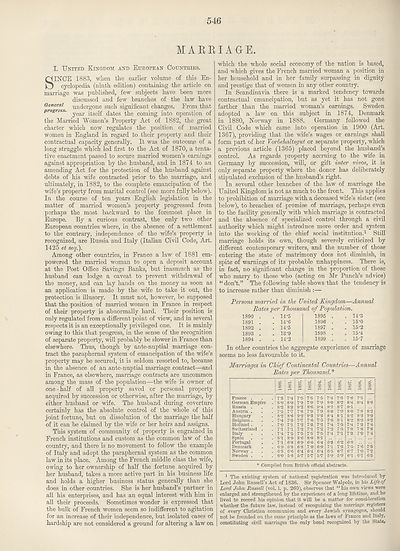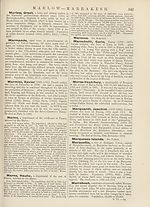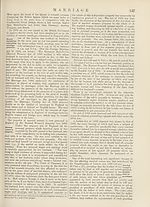New volumes of the Encyclopædia Britannica > Volume 30, K-MOR
(580) Page 546
Download files
Complete book:
Individual page:
Thumbnail gallery: Grid view | List view

546
MARRIAGE.
I. United Kingdom and European Countries.
SIXCE 1883, when the earlier volume of this En¬
cyclopedia (ninth edition) containing the article on
marriage was published, few subjects have been more
discussed and few branches of the law have
General -undergone such significant changes. From that
progress. year ^self dates the coming into operation of
the Married Women’s Property Act of 1882, the great
charter which now regulates the position of married
women in England in regard to their property and their
contractual capacity generally. It was the outcome of a
long struggle which led first to the Act of 1870, a tenta¬
tive enactment passed to secure married women’s earnings
against appropriation by the husband, and in 1874 to an
amending Act for the protection of the husband against
debts of his wdfe contracted prior to the marriage, and
ultimately, in 1882, to the complete emancipation of the
wife’s property from marital control (see more fully below).
In the course of ten years English legislation in the
matter of married women’s property progressed from
perhaps the most backward to the foremost place in
Europe. By a curious contrast, the only two other
European countries where, in the absence of a settlement
to the contrary, independence of the wife’s property is
recognized, are Russia and Italy (Italian Civil Code, Art.
1425 et seq.).
Among other countries, in France a law of 1881 em¬
powered the married woman to open a deposit account
at the Post Office Savings Banks, but inasmuch as the
husband can lodge a caveat to prevent withdrawal of
the money, and can lay hands on the money as soon as
an application is made by the wife to take it out, the
protection is illusory. It must not, however, be supposed
that the position of married women in France in respect
of their property is abnormally hard. Their position is
only regulated from a different point of view, and in several
respects it is an exceptionally privileged one. It is mainly
owing to this that progress, in the sense of the recognition
of separate property, will probably be slower in France than
elsewhere. Thus, though by ante-nuptial marriage con¬
tract the paraphernal system of emancipation of the wife’s
property may be secured, it is seldom resorted to, because
in the absence of an ante-nuptial marriage contract—and
in France, as elsewhere, marriage contracts are uncommon
among the mass of the population—the wife is owner of
one - half of all property saved or personal property
acquired by succession or otherwise, after the marriage, by
either husband or wife. The husband during coverture
certainly has the absolute control of the whole of this
joint fortune, but on dissolution of the marriage the half
of it can be claimed by the wife or her heirs and assigns.
This system of community of property is engrained in
French institutions and custom as the common law of the
country, and there is no movement to follow the example
of Italy and adopt the paraphernal system as the common
law in its place. Among the French middle class the wife,
owing to her ownership of half the fortune acquired by
her husband, takes a more active part in his business life
and holds a higher business status generally than she
does in other countries. She is her husband’s partner in
all his enterprises, and has an equal interest with him in
all their proceeds. Sometimes wonder is expressed that
the bulk of French women seem so indifferent to agitation
for an increase of their independence, but isolated cases of
hardship are not considered a ground for altering a law on
which the whole social economy of the nation is based,
and which gives the French married woman a position in
her household and in her family surpassing in dignity
and prestige that of women in any other country.
In Scandinavia there is a marked tendency towards
contractual emancipation, but as yet it has not gone
farther than the married woman’s earnings. Sweden
adopted a law on this subject in 1874, Denmark
in 1880, Norway in 1888. Germany followed the
Civil Code which came into operation in 1900 (Art.
1367), providing that the wife’s wages or earnings shall
form part of her VorbeholUgut or separate property, which
a previous article (1365) placed beyond the husband’s
control. As regards property accruing to the wife in
Germany by succession, will, or gift inter vivos, it is
only separate property where the donor has deliberately
stipulated exclusion of the husband’s right.
In several other branches of the law of marriage the
United Kingdom is not as much to the front. This applies
to prohibition of marriage with a deceased wife’s sister (see
below), to breaches of promise of marriage, perhaps even
to the facility generally with which marriage is contracted
and the absence of specialized control through a civil
authority which might introduce more order and system
into the working of the chief social institution.1 Still
marriage holds its own, though severely criticized by
different contemporary writers, and the number of those
entering the state of matrimony does hot diminish, in
spite of warnings of its probable unhappiness. There is,
in fact, no significant change in the proportion of those
who marry to those who (acting on Mr Punch’s advice)
“don’t.” The following table shows that the tendency is
to increase rather than diminish :—
Persons married in the United Kingdom—Annual
Rates per Thousand of Population.
1890
1891
1892
1893
1894
14-5
14-6
14-5
13- 9
14- 2
1895
1896
1897
1898
1899
14- 3
15- 0
15-2
15-4
157
In other countries the aggregate experience of marriage
seems no less favourable to it.
Marriages in Chief Continental Countries—Annual
Rates per Thousand*
France .
German Empire
Russia .
Austria .
Hungary
Belgium.
Holland .
Switzerland
Italy
Spain
Portugal
Denmark
Norway .
Sweden .
7- 3 ;
l 8-0 I
8- 2
7- 5 I
8- 2 !
7'4 |
7-0 j
7- 1 !
I 7-4 '
8- 1 |
7-1 S
6-9
6-5 I
6-0 ;
7'5
1 7-9
I 9-4
! 7'9
9-3
' 7-5
; 7-2
7- 2
I 7-5
8- 1
6-4
i 6-4
I 5-7
7- 4
8- 0
9-2
80
8-4
7-8
7'4
7-2
7-4
6- 3
7- 1
6-5
5-9
5-9
7‘5
8'4
7- 8
8- 3
8-3
7-3
7-8
7-0
* Compiled from British official abstracts.
1 The existing system of national registration was introduced by
Lord John Russell’s Act of 1836. Sir Spencer Walpole, in his Life of
Lord John Russell (vol. i. p. 260), observes that “his own views were
enlarged and strengthened by the experience of a long lifetime, and he
lived to record his opinion that it will be a matter for consideration
whether the future law, instead of recognizing the marriage registers
of every Christian communion and every Jewish synagogue, should
not be founded on the same principle as the laws of France and Italy,
constituting civil marriages the only bond recognized by the State,-
MARRIAGE.
I. United Kingdom and European Countries.
SIXCE 1883, when the earlier volume of this En¬
cyclopedia (ninth edition) containing the article on
marriage was published, few subjects have been more
discussed and few branches of the law have
General -undergone such significant changes. From that
progress. year ^self dates the coming into operation of
the Married Women’s Property Act of 1882, the great
charter which now regulates the position of married
women in England in regard to their property and their
contractual capacity generally. It was the outcome of a
long struggle which led first to the Act of 1870, a tenta¬
tive enactment passed to secure married women’s earnings
against appropriation by the husband, and in 1874 to an
amending Act for the protection of the husband against
debts of his wdfe contracted prior to the marriage, and
ultimately, in 1882, to the complete emancipation of the
wife’s property from marital control (see more fully below).
In the course of ten years English legislation in the
matter of married women’s property progressed from
perhaps the most backward to the foremost place in
Europe. By a curious contrast, the only two other
European countries where, in the absence of a settlement
to the contrary, independence of the wife’s property is
recognized, are Russia and Italy (Italian Civil Code, Art.
1425 et seq.).
Among other countries, in France a law of 1881 em¬
powered the married woman to open a deposit account
at the Post Office Savings Banks, but inasmuch as the
husband can lodge a caveat to prevent withdrawal of
the money, and can lay hands on the money as soon as
an application is made by the wife to take it out, the
protection is illusory. It must not, however, be supposed
that the position of married women in France in respect
of their property is abnormally hard. Their position is
only regulated from a different point of view, and in several
respects it is an exceptionally privileged one. It is mainly
owing to this that progress, in the sense of the recognition
of separate property, will probably be slower in France than
elsewhere. Thus, though by ante-nuptial marriage con¬
tract the paraphernal system of emancipation of the wife’s
property may be secured, it is seldom resorted to, because
in the absence of an ante-nuptial marriage contract—and
in France, as elsewhere, marriage contracts are uncommon
among the mass of the population—the wife is owner of
one - half of all property saved or personal property
acquired by succession or otherwise, after the marriage, by
either husband or wife. The husband during coverture
certainly has the absolute control of the whole of this
joint fortune, but on dissolution of the marriage the half
of it can be claimed by the wife or her heirs and assigns.
This system of community of property is engrained in
French institutions and custom as the common law of the
country, and there is no movement to follow the example
of Italy and adopt the paraphernal system as the common
law in its place. Among the French middle class the wife,
owing to her ownership of half the fortune acquired by
her husband, takes a more active part in his business life
and holds a higher business status generally than she
does in other countries. She is her husband’s partner in
all his enterprises, and has an equal interest with him in
all their proceeds. Sometimes wonder is expressed that
the bulk of French women seem so indifferent to agitation
for an increase of their independence, but isolated cases of
hardship are not considered a ground for altering a law on
which the whole social economy of the nation is based,
and which gives the French married woman a position in
her household and in her family surpassing in dignity
and prestige that of women in any other country.
In Scandinavia there is a marked tendency towards
contractual emancipation, but as yet it has not gone
farther than the married woman’s earnings. Sweden
adopted a law on this subject in 1874, Denmark
in 1880, Norway in 1888. Germany followed the
Civil Code which came into operation in 1900 (Art.
1367), providing that the wife’s wages or earnings shall
form part of her VorbeholUgut or separate property, which
a previous article (1365) placed beyond the husband’s
control. As regards property accruing to the wife in
Germany by succession, will, or gift inter vivos, it is
only separate property where the donor has deliberately
stipulated exclusion of the husband’s right.
In several other branches of the law of marriage the
United Kingdom is not as much to the front. This applies
to prohibition of marriage with a deceased wife’s sister (see
below), to breaches of promise of marriage, perhaps even
to the facility generally with which marriage is contracted
and the absence of specialized control through a civil
authority which might introduce more order and system
into the working of the chief social institution.1 Still
marriage holds its own, though severely criticized by
different contemporary writers, and the number of those
entering the state of matrimony does hot diminish, in
spite of warnings of its probable unhappiness. There is,
in fact, no significant change in the proportion of those
who marry to those who (acting on Mr Punch’s advice)
“don’t.” The following table shows that the tendency is
to increase rather than diminish :—
Persons married in the United Kingdom—Annual
Rates per Thousand of Population.
1890
1891
1892
1893
1894
14-5
14-6
14-5
13- 9
14- 2
1895
1896
1897
1898
1899
14- 3
15- 0
15-2
15-4
157
In other countries the aggregate experience of marriage
seems no less favourable to it.
Marriages in Chief Continental Countries—Annual
Rates per Thousand*
France .
German Empire
Russia .
Austria .
Hungary
Belgium.
Holland .
Switzerland
Italy
Spain
Portugal
Denmark
Norway .
Sweden .
7- 3 ;
l 8-0 I
8- 2
7- 5 I
8- 2 !
7'4 |
7-0 j
7- 1 !
I 7-4 '
8- 1 |
7-1 S
6-9
6-5 I
6-0 ;
7'5
1 7-9
I 9-4
! 7'9
9-3
' 7-5
; 7-2
7- 2
I 7-5
8- 1
6-4
i 6-4
I 5-7
7- 4
8- 0
9-2
80
8-4
7-8
7'4
7-2
7-4
6- 3
7- 1
6-5
5-9
5-9
7‘5
8'4
7- 8
8- 3
8-3
7-3
7-8
7-0
* Compiled from British official abstracts.
1 The existing system of national registration was introduced by
Lord John Russell’s Act of 1836. Sir Spencer Walpole, in his Life of
Lord John Russell (vol. i. p. 260), observes that “his own views were
enlarged and strengthened by the experience of a long lifetime, and he
lived to record his opinion that it will be a matter for consideration
whether the future law, instead of recognizing the marriage registers
of every Christian communion and every Jewish synagogue, should
not be founded on the same principle as the laws of France and Italy,
constituting civil marriages the only bond recognized by the State,-
Set display mode to:
![]() Universal Viewer |
Universal Viewer | ![]() Mirador |
Large image | Transcription
Mirador |
Large image | Transcription
Images and transcriptions on this page, including medium image downloads, may be used under the Creative Commons Attribution 4.0 International Licence unless otherwise stated. ![]()
| Encyclopaedia Britannica > New volumes of the Encyclopædia Britannica > Volume 30, K-MOR > (580) Page 546 |
|---|
| Permanent URL | https://digital.nls.uk/193575041 |
|---|
| Attribution and copyright: |
|
|---|---|
| Shelfmark | EB.18 |
|---|---|
| Description | Ten editions of 'Encyclopaedia Britannica', issued from 1768-1903, in 231 volumes. Originally issued in 100 weekly parts (3 volumes) between 1768 and 1771 by publishers: Colin Macfarquhar and Andrew Bell (Edinburgh); editor: William Smellie: engraver: Andrew Bell. Expanded editions in the 19th century featured more volumes and contributions from leading experts in their fields. Managed and published in Edinburgh up to the 9th edition (25 volumes, from 1875-1889); the 10th edition (1902-1903) re-issued the 9th edition, with 11 supplementary volumes. |
|---|---|
| Additional NLS resources: |
|

